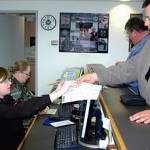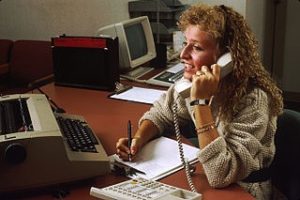Once upon a time, perhaps around 1955, there were four career paths for women. In alphabetical order women could become nurses, secretaries, teachers, or wives. Wives, of course, didn’t work. [Note the fictional aspect here. Of course wives worked, and there were lots of jobs done by women. But technically a job isn’t a career. And now back to the story.]
Nursing and Teaching required a more extensive education beyond high school. So girls who weren’t going to go to college after high school generally drifted towards secretarial work. They could get a jump on their qualifications by taking vocational courses in Touch Typing and Gregg shorthand in high school. [When I was in high school, students in Vocational Education spent their afternoons in job training, a topic of envious conversation among students on the college track.]
The pinnacle of the secretarial profession was the position of Private Secretary, the woman who often had the luxury of only one boss to please, and clerical workers to handle reception and filing. Ann Sothern starred in Private Secretary, a television program that ran from 1953 to 1957. The program focussed on a private secretary devoted to her boss, a handsome talent agent. She, of course, really ran the show. The opening sequence gives a good idea of how most people thought secretaries looked – a well-groomed but not glamorous woman who usually wore glasses. [You get the idea from the opening sequence in this short video, but there’s no reason to watch the credits. LOL.]
SECRETARY’S DAY IS BORN
In 1952 Harry F. Klemfuss, an advertising executive, in conjunction with the U. S. Department of Commerce, created National Secretary’s Week and designated National Secretary’s Day that Wednesday. Klemfuss wanted to emphasize the glamor of a secretarial career. Employers expressed their full appreciation for the way secretaries kept their lives on track by taking the women for a nice lunch and giving them flowers. While recognition is always welcome, one day out of the year doesn’t seem like much.
If you watched Mad Men, you have a good idea of what being a secretary was like in 1962. In this clip, Joan shows Peggy around on her first day. Both women later clawed their way into executive positions, an option not generally open in the 1950s. Cultural expectations still perceived secretaries as women and executives, men. Many thought secretaries slept with executives in order to get ahead, a concept Mad Men writers bought into.
ARE THINGS DIFFERENT IN THE 21st CENTURY?
No one takes shorthand or dictates letters. That’s all done on personal computers or smart phones. No one types. Did you notice the IBM Selectric typewriter in the Mad Men clip?  That was state-of-the-art technology in 1962. Sleek, requiring only a soft touch, and able to switch fonts via interchangeable font elements.
That was state-of-the-art technology in 1962. Sleek, requiring only a soft touch, and able to switch fonts via interchangeable font elements.
In the 21st century executives are expected to keep their own appointment calendars, and write their own texts and letters. They don’t have secretaries. They employ Administrative Professionals to keep their calendars straight and make sure documents are created and filed appropriately. And once a year they celebrate Administrative Professionals’ Week, with an Administrative Professionals’ Day that Wednesday. They still go out to lunch.
DO WE NEED AN ADMINISTRATIVE PROFESSIONALS’ DAY?
Administrative Professionals’ Day is somewhat controversial. Those who favor the recognition argue that others don’t realize how much Administrative Professionals do for the team, especially since one individual provides clerical support for several team members. On the other hand, the day points out the difference between support staff and those they facilitate.
argue that others don’t realize how much Administrative Professionals do for the team, especially since one individual provides clerical support for several team members. On the other hand, the day points out the difference between support staff and those they facilitate.
PERSONAL ASSISTANTS – THE NEW PROFESSIONALS
Personal Assistants, usually referred to as PAs, are new on the administrative scene. A PA may be male or female, though presently females dominate the profession. The PA’s job is to relieve their employers of the mundane, stressful aspects of their professional and/or private lives. “Personal Assistant” is a middle-management position. The Assistant may have her own projects as well as managing those of her boss. She also takes care of travel arrangements, scheduling meetings — anything and everything her boss might need, including running errands.
Sounds to me like what Secretaries used to do.
In the workplace as in life, we all deserve recognition for our contributions. Whether your office has a clerk, secretary, administrative professional, or personal assistant, say thank you. Say it every day, not just this week. If you’re a one-person office, congratulate yourself on a job well done.
☎️☎️☎️
Illustrations from Wikimedia Commons.
IBM Selectric typewriter. Public Domain.
Naval personnel assisting with base passes. Naval Station, Everett, Wash. Public Domain.
The Secretary is Dead. Long Live the PA. Onrec. Jan. 17, 2005.
Alison Green. It’s Time to End Secretaries Day. U.S. News. April 20, 2015.
Personal Assistant Duties. Personal-Assistant-Tips.com

Sandra Wagner-Wright holds the doctoral degree in history and taught women’s and global history at the University of Hawai`i. Sandra travels for her research, most recently to Salem, Massachusetts, the setting of her new Salem Stories series. She also enjoys traveling for new experiences. Recent trips include Antarctica and a river cruise on the Rhine from Amsterdam to Basel.
Sandra particularly likes writing about strong women who make a difference. She lives in Hilo, Hawai`i with her family and writes a blog relating to history, travel, and the idiosyncrasies of life.


